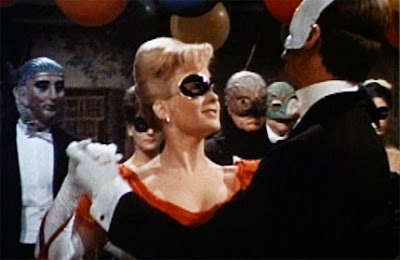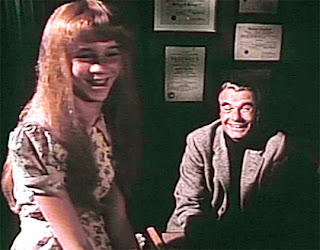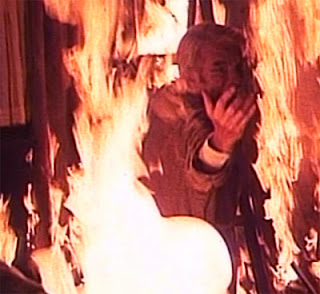Now Playing: Kiss of the Vampire (1963)
Pros: Startling pre-title sequence; Good cast; Nicely crafted simmering suspense
Cons: Some annoying plot inconsistencies; An ambitious finale is done in by bargain basement effects
This post is part of the Hammer Halloween Blogathon hosted
by the Classic Film & TV Café. Click here for the complete blogathon schedule.
About a week or so ago as I was searching the internet for the meaning of life, a pop-junk business article caught my eye: "
12 Jobs on the Brink: Will They Evolve or Go Extinct?" I don't why it resonated with me, since at the moment I have no job, evolving, evolved, extinct or otherwise. (On the other hand, I am rapidly going extinct as a person -- or should I say expiring? -- and all those applications of Just for Men's Touch of Gray™ don't seem to be slowing down the process any.) It was one of those slideshow thingies for time-pressed and literacy-challenged people who prefer clicking on arrows and looking at captioned pictures versus scrolling through paragraphs and paragraphs of **SHUDDER** black and white text.
What really caught my eye was the pic that accompanied the article teaser. It was of a woman with a stack of books in one arm holding her index finger to her lips in the stereotypical librarian shushing pose -- although in this case, the woman was fairly young, attractive, and did
not have her hair done up in a bun. Having been a librarian for many years, the old, hoary notion of librarians as shushers and killjoys drives me absolutely nuts, but I was nonetheless intrigued by the mixed messages conveyed by the picture. Against my better judgment I clicked on the link, prepared to be outraged at the lies and slanders that some insouciant twenty-something business writer would no doubt spew about my former profession. Of course, Librarian was first on the list of 12 jobs on the brink, but to my astonishment, the verdict of the profession was "evolved"… apparently in the Google age there's still room for people who know their way around the digital information landscape, and who are "savvy with searches, keywords and helpful websites."

Other jobs like video store clerk and newspaper deliverer got the brutal extinct judgment. Still others, like travel agents and supermarket cashiers were said to be evolving, but librarians, at least according to this one business writer, are not just evolving, but fully evolved. Huh. While the final bit of advice to workers was particularly weak -- "Watch big picture trends, update your skills and direction as necessary, and get personal" -- it did get me thinking about other occupations that are rapidly going extinct. Take the various homicidal maniacs, devil worshipers and assorted monsters that lie in wait until such time as they can "get personal" with unwary travelers. With GPS as standard equipment in almost every car and cellphone these days, fewer travelers are getting lost, and even if they do get stuck on a deserted road, chances are they can call for roadside assistance instead of hiking up to that creepy old house or castle to get help. Sure, there are plenty of cellular dead zones, and there's still a chance that a chainsaw maniac or decrepit vampire might snag a lost tourist here or there, but it's becoming an increasingly hard way to make a killing.
Fortunately for horror fans, Hammer's
Kiss of the Vampire is set in a time long before GPS and cellphones, in the early automobile age when horseless carriages were sputtering, noisy curiosities that had a tendency to break down on lonely roads next to decaying castles swarming with vampires. Needless to say, there was no AAA around to bail you out. After an eye-opening pre-titles sequence (more on that later), the 1903 De Dion Bouton model Q motorcar belonging to honeymooners Gerald and Marianne Harcourt (
Edward de Souza and
Jennifer Daniel) does just that. (According to
IMDb trivia, the car was loaned to Hammer by the National Motor Museum). Handsome Gerald good-naturedly blames his new bride's poor map-reading skills for their being lost and without petrol (that's gas for us Americans), then sets out for the nearest village for help after telling Marianne that she'll be safe in the car (which is completely open to the elements and wandering wolves and vampires… yeah, right…)
 |
| "Little Red Riding Hood, what big teeth you have!" |
When hours go by and Gerald still isn't back, Marianne gets antsy and starts down the road herself, only to be intercepted in the twilight by the severe, mysterious bearded man we saw in the pre-titles segment, who gruffly warns her to get back to the motorcar. Meanwhile, the breakdown and Marianne's encounter are being watched via telescope by another mysterious man in the nearby castle. Gerald finally returns with a local and his horse-driven wagon, who tows the motorcar and the Harcourts into the nearby village.
The couple end up in a village that seems devoid of people, in front of a run-down hotel that looks like it hasn't had a guest in years. Without any other options, Gerald manages to secure a room from the reluctant innkeeper and his dour wife. Bruno the innkeeper (
Peter Madden) brightens up when, in retrieving the couple's bags, he sees rice in the nooks and crannies of their belongings and concludes that they're newlyweds. He unsuccessfully tries to cheer up his wife Anna (
Vera Cook), who seems to be harboring a deep and abiding sadness.
That evening, a carriage arrives at the hotel with an invitation for "the English couple staying at the hotel" to join Dr. Ravna (
Noel Willman) and his family for dinner at the castle. Although Gerald doesn't understand how anyone knows they're staying at the hotel, Bruno encourages the couple to accept the invitation, telling them that Ravna sets one of the finest tables in all the country, and explaining that while his wife is a good woman, her cooking is not so great.
The Harcourts agree to go, and find themselves in a magnificently appointed and well-lit abode that belies the castle's creepy, rundown exterior. Dr. Ravna is an elegant, if somewhat foppish middle-aged man. He introduces the Harcourts to his beautiful daughter Sabena (
Jacquie Wallis) and handsome son Carl (
Barry Warren), who seem much more normal than their patrician father. Ravna is an odd duck, admitting to the couple that he spied on them with his telescope. He also explains cryptically that he was a scientist who made a "mistake," and was forced to give up his position and move to his ancestral castle in the hinterlands. When he starts in on the ugly origins of life's pleasures -- how the excellent wine they had with dinner started out as grapes mashed by dirty peasant feet, and the duck they feasted on was first strung up by hunters, Sabena judiciously cuts him off. Recovering his pleasant demeanor, Ravna offers to send for petrol, but tells the couple they'll have to stay over for another night.
 |
Marianne (Jennifer Daniel) is mesmerized
by Carl's dark, brooding music. |
Carl treats the guests to one of his compositions on the piano. The dark, haunting music practically puts Marianne into an hypnotic state. Coming back from the dinner party, Gerald and Marianne hear Anna crying softly in a nearby room. Being busybodies, they quietly open the door and see Anna sitting on the floor next to a cabinet, clutching a white dress and a framed photo. They softly close the door before the distraught woman can see them. When Gerald tries to pump the hotel's only other guest, Prof. Zimmer (
Clifford Evans) for information, he gets rebuffed. (Zimmer's the same man who gruffly warned Marianne to get back to her car. The audience knows a bit more about what's wrong with the village from an earlier scene in which Zimmer intercepts a red-hooded vampire woman from the castle trying to dig up the latest convert from her grave. Zimmer gets bitten on the wrist for his troubles and has to soak the wound with alcohol and set fire to it to sterilize the undead cooties.)
After breakfast, Sabena and Carl show up at the inn with some good news and some bad news. The bad news: it will take several more days to get the petrol. The good news: the family is hosting a grand party at the castle with music, dancing and food brought in from Paris, and Marianne and Gerald are of course invited. When Zimmer appears and grimly announces to the Ravna siblings that the weather seems to be getting better and the sun is coming out, the pair seem panicked and rush to their carriage (but not before getting the Harcourts to agree to come). Later, as the Harcourts prepare to go back to the castle, a visibly distressed Zimmer warns Marianne to be careful.
 |
Marianne and Carl dance as an assortment of
upper-crust gals and ghouls looks on. |
Ravna's party is a fancy one, but also a bit peculiar. The ladies wear dainty eye masks, while the gentlemen sport an assortment of grotesque over-the-head masks. Gerald is given a bright-red devil mask, while Carl takes Marianne off to the dance floor. All eyes are on the pair as they swirl around, Marianne seemingly entranced (or hypnotized) by her partner. Meanwhile, Sabena is plying the unsuspecting Gerald with alcohol. After the dancing, Marianne is lured to the upper floor of the castle by a man in a devil mask that she at first assumes is Gerald. At the moment she realizes the man in the mask is not her husband, Carl, leering, tears the mask off, shoves her into a spacious room and locks the door. There she encounters Dr. Ravna lying in a coffin-like enclosure off the main room, blood dribbling from the corner of his mouth. Uh-oh!
Later, Gerald wakes up from his alcoholic blackout and finds the castle deserted. When he asks Carl where Marianne is, the now very hostile young man claims that he he's never heard of a "Marianne," that Gerald came to the castle alone and has worn out his welcome. Carl is unceremoniously dumped outside by a hulking henchman. When he stumbles back to the hotel, Bruno too pretends to have never heard of or seen his wife. Gerald is astonished to find that all of Marianne's clothes and effects have disappeared from their hotel room.
Just when Gerald thinks he's going out of his mind, Zimmer matter-of-factly tells him that Marianne is being held at the castle. It seems Zimmer has been tracking Ravna and his followers for some time, and now that the moon is full and Saturn is lined up with Capricorn (?!), he has a plan to turn evil against evil (or something like that). Will the scheme succeed before Marianne is completely absorbed into Ravna's macabre den of iniquity?
With the exception of the opening sequence (yes, yes, I'm getting to that),
Kiss of the Vampire takes its time to develop an atmosphere of dread rather than letting the technicolor blood flow like Hammer's vampire offerings featuring Lee and Cushing. Ravna and his family first seem no more than eccentric at the dinner party, then by the time of the masqued ball, we know something's really, really wrong with these people.
 |
Gerald (Edward de Souza) enjoys a glass of wine
while Ravna (Noel Willman) ogles Marianne. |
Kiss is probably most effective in a first viewing, provided you're in a tolerant, "let it flow" frame of mind. With subsequent viewings (yes, I've seen it more than a few times) its inconsistencies and logical lapses pop up in the midst of the carefully constructed suspense like some joker wearing a tuxedo t-shirt to a fancy ball. If no one comes to the village any more, how do hotel keepers Bruno and Anna even make a living? How is it that no one who's left in the village (with the exception of Zimmer) seems to make the connection between the eccentric Ravna and the deaths and disappearances of so many of the area's young women? Why is Bruno so happy to send the honeymooners up to the creepy castle? Why does Zimmer, who knows better, refuse to talk when pressed by Gerald, and can only stir himself to warn Marianne to "be careful" when the couple get in the carriage to go to the castle? And when he does take action, why does Zimmer recommend waiting until night (?!) to try to rescue Marianne after she's been kidnapped?
These pesky "huh?" moments are more than compensated for by the film's masterful building of tension and some original touches. Without going into too much detail,
Kiss of the Vampire's opening scene takes the horror movie cliche of the somber cemetery burial and adds some bloody red technicolor spice to it. This scene contributed to one of my Most Memorable Early Movie Moments™. I was nine or ten, watching it at the drive-in (of course!), and when the unexpected thing happened, I literally hid my eyes with my hands. Still, it was a good frightful feeling, and
Kiss of the Vampire has been one of my favorites ever since.
Although I suppose you might call
Kiss' cast a sort of Hammer vampire B team, it's a very good B team. Dashing
Edward de Souza (Gerald) was already a veteran of Hammer's underrated
The Phantom of the Opera (1962, with Herbert Lom; this would be one of de Souza's last features before TV took over the rest of his career).
Clifford Evans had been working in movies and TV for nearly 30 years, and had appeared in Hammer's
Curse of the Werewolf (1961) before joining the cast as the grim, determined Zimmer.
Jennifer Daniel (Marianne) has worked mostly in TV over the course of her decades-long career -- most notably (at least for horror fans), in such shows as
One Step Beyond (1961),
Suspense (1962), and Brian Clemens' 70s series
Thriller (she also appeared in Hammer's 1966 shocker
The Reptile).
 |
The supposedly classy Dr. Ravna is a drooler and
sleeps with his eyes open. Eeewwwwww!!!! |
In their book
The Hammer Story: The Authorised History of Hammer Films, Marcus Hearn and Alan Barnes report that Noel Willman was initially dubious about the role of Dr. Ravna. He supposedly confided to co-star de Souza, "I intend to play this part without changing my expression once." Dubious or not, Willman is very effective as the sinister patrician vampire and devil-worshipping cult leader. Early in the film, when he greets the naive honeymooners for the first time in his castle lair, he channels Bela Lugosi as he walks slowly down the darkened steps: "You expected the inside of my house to be as unattractive as the outside, is that it? If it were, I could not live here. I like only to be surrounded by beautiful … things." The hitch in his voice as he says "things" recalls Lugosi's famous line from the 1931
Dracula, "I never drink… wine."
In his Hammer film debut, Australian director
Don Sharp manages to build a nice, atmospheric chiller with little bits of business like this. Another understated yet effective scene is the great masqued ball at the castle. As Carl and the beautiful Marianne whirl around the dance floor, the camera pans the row of guests who have stopped their dancing to watch. The women are normal enough looking with their simple eye masks, but the men are all wearing hideous, disturbing masks. It's as if the dancers are being observed by an assortment of demons and ghouls.
According to Hearn and Barnes, Sharp was largely responsible for
Kiss' emphasis on atmosphere over blood and shock scenes. They quote Sharp:
"What worried me was that, as Hammer progressed, the goal seemed to be for each picture to top the one before it and they were becoming satiated with violence. So I persuaded [producer] Tony [Hinds] that it was better to suggest 'is it going to happen?' and give the audience a little touch of it, and go on and really get your big shock in the end." [Ibid.]
 |
| It's two-for-one bat night at Ravna's castle. |
Sharp's less-is-more philosophy works throughout most of the film -- until the "big shock" at the climax. Again, without giving away everything, bargain basement special effects in the form of
rubber bats reputedly purchased from a local Woolworth's store (?!) almost turn the shock ending into an unintentional laugh fest. Instead of conveying a feeling of terror, some of the characters grapple with the cheap bats as if they were clumsy parents fumbling with particularly irksome Halloween decorations.
Still, don't let the rubber props spoil your enjoyment of this above average Hammer film. It may not kiss like a French person, but its subtleties and slow-building suspense make for a great horror movie date nonetheless.
Where to find it:
Oldies.com (2 DVD Hammer Horror Series)
"A spine-chilling drama of two young people who strayed by chance into a nightmare, in a twilight world of terror!"















































